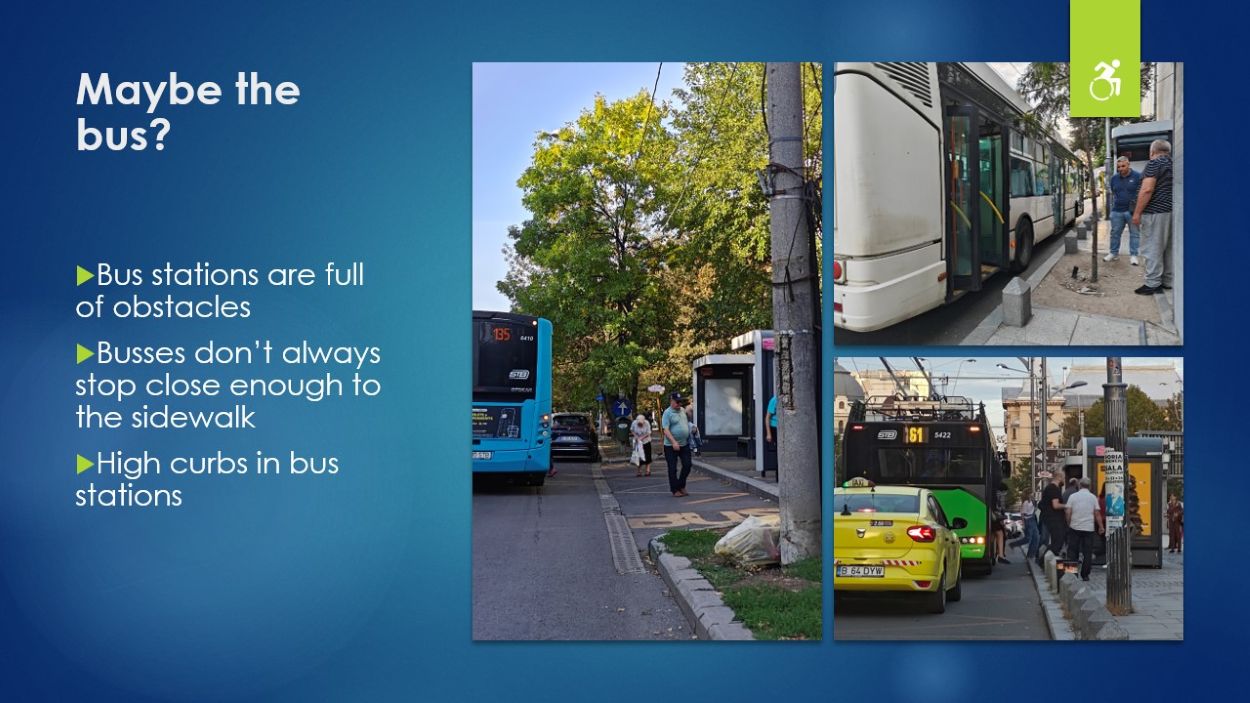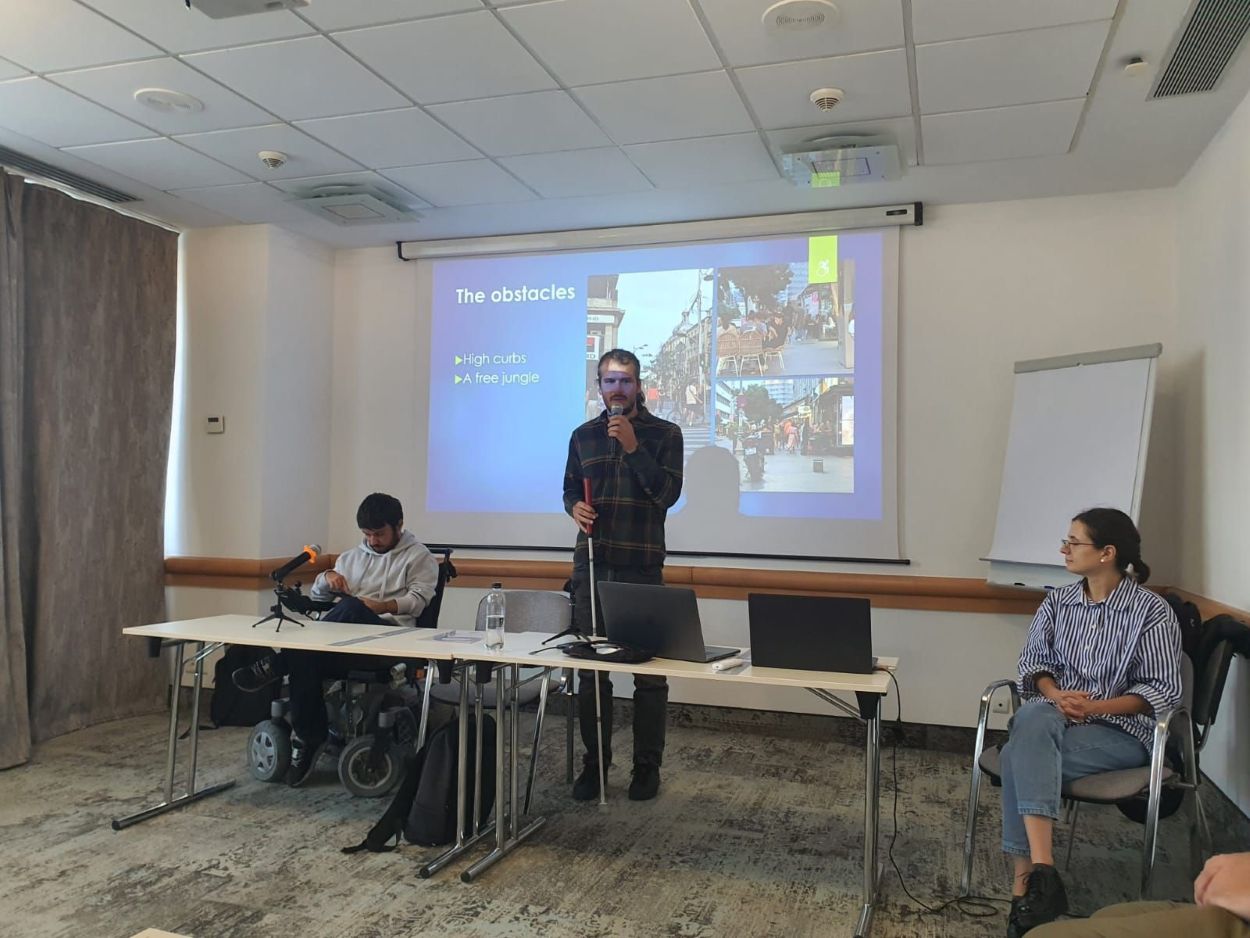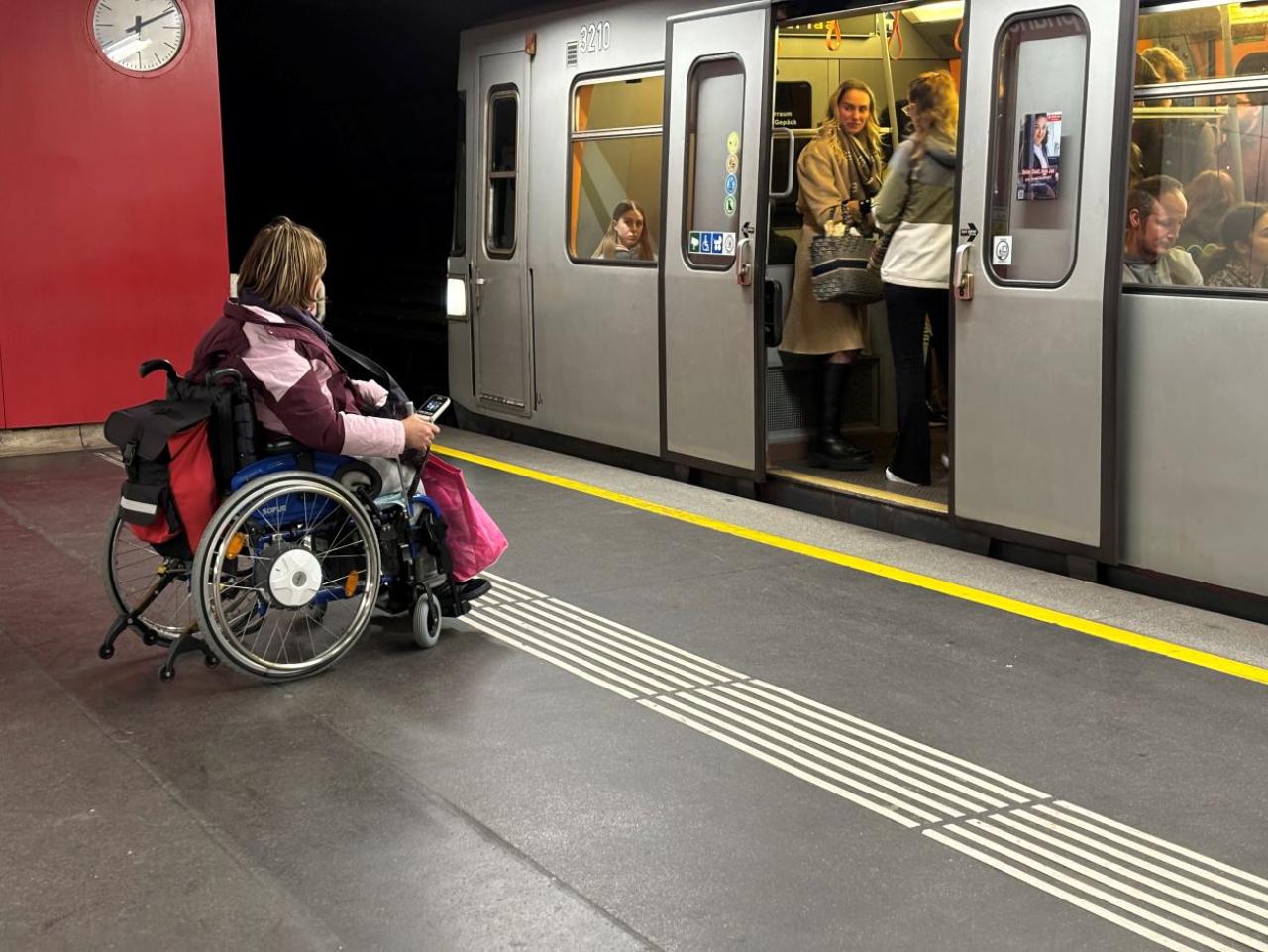Accessibility and inclusion have frequently appeared in numerous EU documents and reports from both public and private entities. Despite the emphasis on these concepts and the available online resources, they are often treated as exceptions rather than standard practices, particularly in the built environment. How does this lack of prioritization in design impact us, and why is it crucial to make a change?
The Beyond the Urban URBACT network recently held a workshop titled “Enhancing Urban Spaces for Active Mobility and Accessibility". The participants examined how the built environment can contribute to social segregation and higher dependency on cars. They discussed the importance of shifting accessibility from being viewed as a "special case"1 to becoming a core priority in urban mobility.
Inclusive Design in Mobility: Setting the Context
An inclusive approach to design is critical for urban and rural mobility, especially in fostering equitable access and participation across diverse communities. Why is this important?
As per European statistics2 in 2023, 26.8% of the EU population reported some sort of disability or limitation due to health issues. With an increase in life expectancy, which means an aging population, Europe should reconsider inclusive mobility systems' role for a future thriving community. Until 2070, 62.5% of the EU population will be over 65 years old3. Aging also changes and limits people’s abilities.
The definition of disability can vary by country and data source. Still, it is time to look more closely at disabilities beyond the medical model to prioritize accessibility in any project. The medical model of defining disability focuses on the individual's abilities, health condition, or the medical cause of the disability. Whereas the social model expands the spectrum of what disability is by defining it as a “mismatch between one’s abilities and the environment”4 (built, digital, natural, etc.). Hence, the focus shifts to how the environments are designed, not the people and their abilities. And disabilities can be created even where there is no legal document stating a permanent disability.
However, there is a need for a balance between the two definition models. They should not be seen as opposing each other, considering the diversity of disability types: permanent (e.g., a person with an amputated limb), temporary (e.g., a person recovering after an invasive surgery), or context-based (e.g., an able-bodied parent trying to push a stroller on a sandy beach).
The absence of accessibility and inclusion in urban and rural mobility projects can result in discrimination based on age, gender, abilities, culture, and other factors. Among the most affected groups, individuals with permanent disabilities may face more significant exclusion, but they are not the only ones impacted. And this brings a lot of issues, the most relevant for the topic of active mobility being:
- less visibility of people with permanent disabilities in public spaces, thus less attention on issues related to mobility and accessibility;
- longer times to plan trips in public spaces due to unpredictability5;
- enhanced car-dependency (personal or shared services) because public facilities are not accessible.
Two of the examples discussed in the workshop were from European capitals, with very diverse backgrounds yet similar attitudes regarding the accessibility of public transport.
The first example was from Bucharest, Romania, a photo taken in 2023, where the people at a bus stop are helping a mother to pick up the baby stroller and place it into the inaccessible bus. Yes, sometimes it takes a village to raise a child in an unfriendly environment.
Image 2. Taking the bus in Bucharest. The image shows how the people in a bus station are trying to help a mother get on a bus with a baby stroller and without a ramp. (Source: Iris Popescu, 2023)
The second photo is from Berlin, Germany, taken in 2024. The bus stop is divided from the sidewalk by a bicycle lane. As the photo shows, one wheelchair user getting out of the accessible bus intersects with cyclists, and accidents can happen because of this design.
Image 3. Taking the bus in Berlin. The image shows a wheelchair user intersecting with cyclists on a bike lane when getting off the bus. (Source: Iris Popescu, 2024)
Accessibility and Mobility Solutions
A base of solutions already exists that can be applied to support an active mobility infrastructure that fosters accessibility. We can ensure that people of diverse abilities, genders, and ages have opportunities to engage in sustainable, healthy, and safe forms of transportation. These solutions start with understanding the basic design norms and standards related to the accessibility of the built environment:
- sidewalks and public transport stations/stops with proper dimensions for diverse types of mobilities (pedestrians, wheelchair users, parents with strollers, cyclists etc.), proper materials that differentiate the surface from car areas both visually and tactile, using visual and tactile markings, especially before possible obstacles, like crossings or access to public transport;
- designing diverse spaces for resting/sitting in public spaces;
- offering accessible facilities like restrooms, water fountains, bike lanes separated from traffic, facilities, and stations with adaptive bicycles for people with disabilities who may not be able to use standard bicycles.
- inclusive wayfinding systems for information and orientation;
- proper lighting in public spaces that supports the contrasts between surfaces used without glare or shadows that generate visual confusion, and so on.
Nowadays, physical solutions related to accessibility can be enhanced by combining architecture with technology. Tech-driven enhancements like smart lighting, interactive navigation aids or apps, and sensor-based accessibility tools not only improve functionality but can also enrich users' experiences. This base is an early start of an inclusive approach because just applying standard solutions is not always enough.
In the workshop, participants examined a case from Norway on public transport accessibility. A 2016 study6 revealed that, despite investments in making public transport facilities more accessible, there was no notable increase in usage by people with disabilities. The research focused on exploring ways to improve this outcome, that mainly revolved around7:
- Making sure there are hazard-free footpaths to the public transport facilities offered.
- People with disabilities might have biases related to the facilities offered: there is also a need for investment in campaigns that communicate the changes to ensure people feel secure and confident using these services.
- Informing the community: after implementing accessibility solutions, ensure that people understand their benefits, know how to use them, and can easily find them.
- Educating the people who will provide the facilities for the community on accessibility and inclusion (e.g., a significant barrier to usage is the limited knowledge and assistance provided by drivers and personnel).
- The most important aspect of an inclusive process is what they actually did with the study—involving the community in understanding the obstacles faced and developing solutions.
Collaborative Approaches
Involving a diverse range of people in identifying obstacles and developing solutions is essential to the foundation of inclusive design. When people with different abilities, backgrounds, and perspectives are actively engaged, it ensures that the resulting solutions address real-world challenges from multiple angles. This diversity fosters empathy and creativity in the design process, allowing teams to uncover hidden barriers that may otherwise go unaddressed. Moreover, inclusive design goes beyond meeting standards; it offers subtle solutions that cater to the needs of a diverse range of users.
Given that the workshop was on inclusive design, the trainer's professional experience was complemented by real-life stories. The two guest speakers, Alexandru Cucu8 (one of the 8 blind active IT engineers in Romania and Tech Lead AMAIS) and Alexandru Tache9 (IT specialist, disability rights activist, and electric wheelchair user), brought information on their experience with urban and rural mobility, showcasing the diversity of perspectives and why just applying standard solutions does not directly ensure universal accessibility.

Image 4. The slide states why the bus is not an option for him, leading to his car dependency. (Source: Alexandru Tache, 2024)
Other examples of collaborative approaches or instruments that reveal information on a broad spectrum of people related to mobility are:
- https://trips-project.eu/ - The TRIPS project is a collaborative initiative aimed at improving the accessibility and inclusivity of public transport systems across Europe. It empowers people with disabilities to co-design mobility solutions that meet their needs. The project also offers information on “Views of Persons with Disabilities on Future Mobility” and a design toolkit.
- https://diamond-project.eu/ - The DIAMOND project leverages data-driven approaches to foster gender inclusion in transport systems. It analyzes diverse needs to design fair and efficient mobility solutions for all users.
- https://www.indimoproject.eu/ - The INDIMO project aims to enhance the mobility of people with disabilities by developing innovative, accessible, and user-friendly transport solutions by collaborating with diverse stakeholders across Europe.
- https://include.amais.ro/experiences/ - A platform that offers a series of stories on the experience with public spaces and exclusion from diverse perspectives and is open to adding new stories.
- https://universaldesignguide.com/playbook/ - Explores and gathers methods and activities to create the perfect workshop for your Universal Design Process and support creating innovative, inclusive solutions.
Long-term Impacts
An inclusive approach to Beyond the Urban is essential for achieving the EU's Cohesion Policy goals of reducing regional disparities and promoting sustainable, inclusive growth. By improving rural-urban mobility, this initiative fosters greater connectivity, enabling equitable access to opportunities and services for all, particularly in underserved rural and remote areas. It aligns with the EU's focus on social and territorial cohesion, environmental sustainability, and innovation, ensuring that a diverse range of people benefit from improved transport options. As we look toward the future, it's clear that accessibility and inclusion must become priorities in every project—no matter in which category we see ourselves now, circumstances can change, our bodies and needs change throughout our lives, and this topic includes all of us. It's time to act and make inclusive design the standard, ensuring a genuinely accessible and fair future for the community.
1. Jos Boys, Doing Disability Differently: An alternative handbook on architecture, dis/ability and designing for everyday life, Routledge, London, 2014, pp. 30-31.
2. Eurostat data, Population with Disability. Available online: https://ec.europa.eu/eurostat/statistics-explained/index.php?title=Population_with_disability#Self-reported_disability_.28limitation_in_usual_activities_due_to_health_problems.29
3. Information from the “The 2021 Ageing Report: Economic and Budgetary Projections for the EU Member States (2019-2070)”. Available online:
https://economy-finance.ec.europa.eu/publications/2021-ageing-report-economic-and-budgetary-projections-eu-member-states-2019-2070_en
4. Kat Holmes, Mismatch - How Inclusion Shapes Design, MIT Press, 2020, pp. 51-52.
5. Anne Kathrine Frandsen, Inge Storgaard Bonfils and Leif Olsen, Universal design Cross-disciplinary perspectives in theory and practice, “Dependency sensitivity via universal design”, Aalborg Universitet, 2024, pp. 100-105. Available online: https://portal.findresearcher.sdu.dk/files/263039308/Universal_design_UK.pdf
6. Kjersti Visnes Øksenholt, Jørgen Aarhaug, Public transport and people with disabilities – the experiences of non-users, Institute of Transport Economics, Norway. Available online: https://universaldesignaustralia.net.au/wp-content/uploads/2017/02/public-transport-and-people-with-disabilities.pdf
7. Ibidem.
8. Article about Alexandru Cucu, romanian text, but can be translated with GoogleChrome: https://www.libertatea.ro/stiri/ochii-mintii-povestea-tanarului-nevazator-care-transforma-maseurii-in-it-isti-suntem-doar-sase-programatori-masajul-este-meseria-principala-4566131
9. Article about Alexandru Tache, romanian text, can be translated with GoogleChrome: https://life.ro/alex-tache-it-istul-sofer-de-suflet-ce-face-voluntariat-din-scaunul-cu-rotile-viata-persoanelor-cu-dizabilitati-in-romania-e-usoara-dar-cu-o-conditie-sa-ai-bani/



